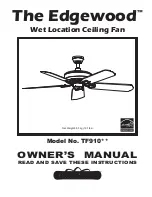
10
Problem
Fan will not start.
Fan sounds
noisy.
Remote control
malfunction.
Fan wobble.
Solution
1. Check circuit fuses or breakers.
2. Check line wire connections to the fan and switch wire connections
in the switch housing. CAUTION: Make sure main power is off.
3. Check to make sure the dip switches from the transmitter and
receiver are set to the same frequency.
1. Make sure all motor housing screws are snug.
2. Make sure the screws that attach the fan blade bracket to the motor
hub is tight.
3. Make sure wire nut connections are not rubbing against each other
or the interior wall of the switch housing. CAUTION: Make sure main
power is off.
4. Allow a 24-hour "breaking-in" period. Most noise associated with a
new fan disappear during this time.
5. If using an optional light kit, make sure the screws securing the
glassware are tight. Check that light bulb is also secure.
6. Do not connect the fan with wall mounted variable speed control (s)
7. Make sure the upper canopy is a short distance from the ceiling. It
should not touch the ceiling.
1. Do not connect the fan with wall mounted variable speed control (s)
2. Make sure the dip switches are set correctly.
1. Check that all blade and blade arm screws are secure.
2. Most fan wobbling problems are caused when blade levels are
unequal. Check this level by selecting a point on the ceiling above
the tip of one of the blades. Measure this distance. Rotate the fan
until the next blade is positioned for measurement. Repeat for each
blade. The distance deviation should be equal within 1/8".
3. Use the enclosed Blade Balancing Kit if the blade wobble is still
noticeable.
4. If the blade wobble is still noticeable, interchanging two adjacent
(side by side) blades can redistribute the weight and possibly result
in smoother operation.
WARNING: TO REDUCE THE RISK OF PERSONAL INJURY, DO NOT BEND
THE BLADE ARM WHILE INSTALLING, BALANCING THE BLADES, OR
CLEANING THE FAN. DO NOT INSERT FOREIGN OBJECTS BETWEEN
ROTATING FAN BLADES.
13. TROUBLESHOOTING





























